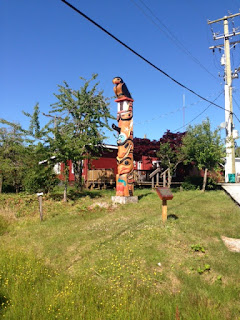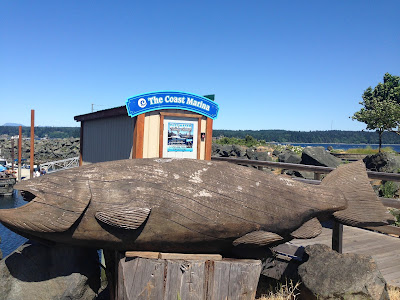Moving north we planned to go to Comox but Tom our friend from Vancouver, suggested we stop short and stay at Tribune Bay located in the hook of Hornby Island. It was good advice.
The anchorage is located at "Tom Recommends" and is well protected from NW winds. Good thing! It blew from 20 -30 kts for the next several days. Our anchorage was safe from any wave action but at 25 kts several of the antenna and mast supports on WORKNOT start to sing. Over the years learned to measure the wind by what is singing. Confirmed by the wind meter each day the forecast called for Gale warnings further north extending to Johnstone Strait. This is a must pass location on our way to Alaska.
On the way we saw lots of drift wood and logs. A bird was nice enough to sit on this one making it easy to see. Won't be that lucky and a careful watch is needed. Some logs float vertically and bob just below the surface. These "deadheads" can do real damage to a boat and its underwater gear. WORKNOT and many trawlers have a protected prop and rudder arrangement but we are all vulnerable.

The tide swing this time of the month is about 11 ft. At max tide it can be as much as 15 ft. This makes for a wide beach with lots of room twice a day. People were swimming, splashing around and generally enjoying a day at the beach. We took kayaks ashore and found the water OK for wading. The shallow water was warmed by the sun but quickly got colder as the water got deeper. Too cold for me to consider swimming but plenty of kids and few hardy adults were game. Another nice park adds to the charm of this quiet and scenic anchorage. One local boater referred to Tribune Bay as the "Hawaii" of British Columbia.
Here is Mary suggesting I not take her picture as she strolls the beach. In 6 hours the beach will be less than 25 feet wide.
Rock formations along this cove are interesting. These channels are in rocks that dry during each tide cycle. Imagine the time it took for the water to carve these stones. Some of the channels are over 100 ft long.
Mary approved this picture of a major piece of drift wood on the shore. If we had a front yard it would make a great focus piece, just not sure how to get it home.......
Sunsets are great with the trees and blue skys. Check the surface of the water, still windy.
More potential yard art from the beach.
The forecast did not improve but wanted to make it thru the Seymour Narrows and get to Johnstone Strait before the weather closed in. Running the narrows requires us to be at slack water as we pass. Reading the guide books about the currents in these areas is enough to send me back to the desert. This time of the month currents peaks at about 9.5 kts. (This is near the maximum speed WORKNOT is capable of). Timing is everything.
Wikipedia says:
Seymour Narrows was described by Captain
George Vancouver as "one of the vilest stretches of water in the world."
[2] Even after
Ripple Rock was removed, it remains a challenging route. In March 1981, the Star Philippine, a freighter, ran aground in the narrows.
Seymour Narrows is notable also because the flowing current can be sufficiently turbulent to realize a
Reynolds number of about

, i.e. one billion, which is possibly the largest Reynolds number regularly attained in natural water channels on Earth (the current speed is about 8 m/s, the nominal depth about 100 m). Turbulence develops usually around a Reynolds number of 2000, depending on the geometric structure of the channel.
Just after leaving the safe anchorage of Tribune Bay and turning north into the Strait of Georgia winds were running about 25-30 kts at 7 AM. Wind waves of 3-4 ft spaced very closely with occasional 5 ft waves were already well established and building. After about 2 miles made the most difficult maneuver any skipper has to make. Turned around, went back to the place we left and had breakfast.
Waited another two days and the wind was still in the 20's and not forecast to improve. Gale warnings at Johnstone Straits continued.
Two big surprises on our trip so far are did not expect to be in shorts, wading around in warm water and did not expect to be weathered in on the leeward side of Vancouver Island. The water went from a lake to choppy mess in 24 hours.
BOX SCORE: 6 HOURS 19 Gallons 42 miles
Keela wondering is she has returned to the warm beaches of Mexico
We finally left on 6/8/15 and still had a bumpy but OK ride to Campbell River.






















































